Stone Origins
Turquoise Origins:
The Mines Behind Our Jewelry
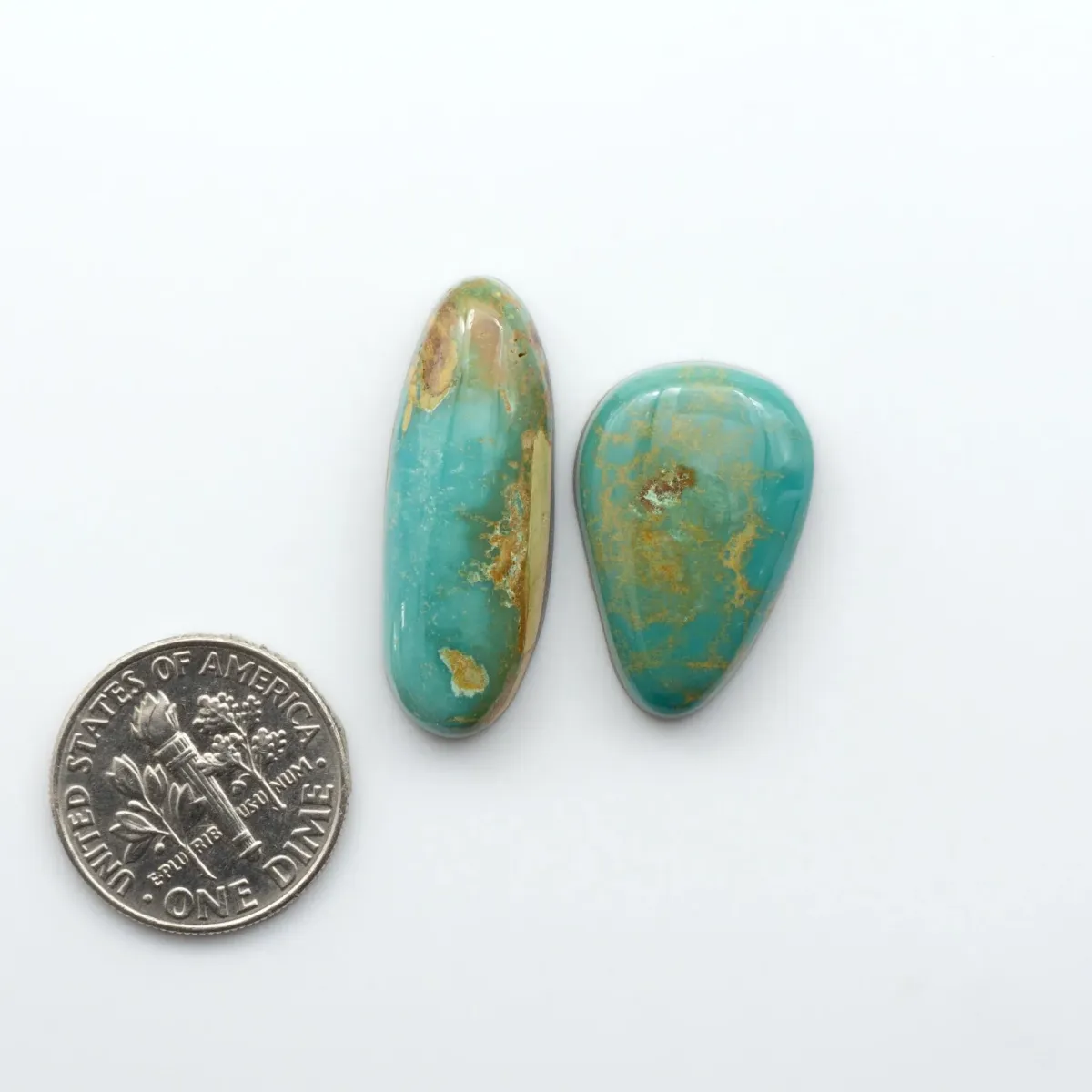
Image used with permission from
Kings Manassa Turquoise — Colorado
The Kings Manassa mine is Colorado’s oldest and most storied turquoise source, now proudly owned and operated by the Cordova family of Manassa. Discovered in the late 1800s by a Navajo sheepherder, this mine has produced legendary green to blue-green stones with distinctive golden-brown matrix—shaped by the region’s unique mineral chemistry.
For decades, the King family worked this claim, passing down knowledge and tradition. Today, the Cordova family continues that legacy, stewarding the land and carefully selecting each stone by hand. Kings Manassa turquoise is rare, as most material was mined years ago, making every piece a true heirloom of Colorado’s high desert.
Perfect for: Featuring heritage, Cordova family stewardship, and the unique green hues of Colorado turquoise.
White Buffalo (Stone) — Nevada
White Buffalo isn’t turquoise, but it’s become a Southwest icon in its own right. This striking white stone with bold black or brown matrix is found only in a handful of claims in Nevada, now jointly stewarded by the Otteson Family and the Cordova Family of Manassa.
The stone’s discovery is credited to the Ottesons, legendary Nevada miners, but today both families work these claims, honoring a tradition of careful, small-batch extraction. Each White Buffalo stone is shaped by ancient volcanic activity and the hands of modern lapidaries—no two are exactly alike. Its bold contrast and rarity make it a favorite for artists and collectors seeking something truly different.
Perfect for: Explaining what makes White Buffalo unique, and honoring the Otteson and Cordova families’ shared stewardship and commitment to ethical mining.
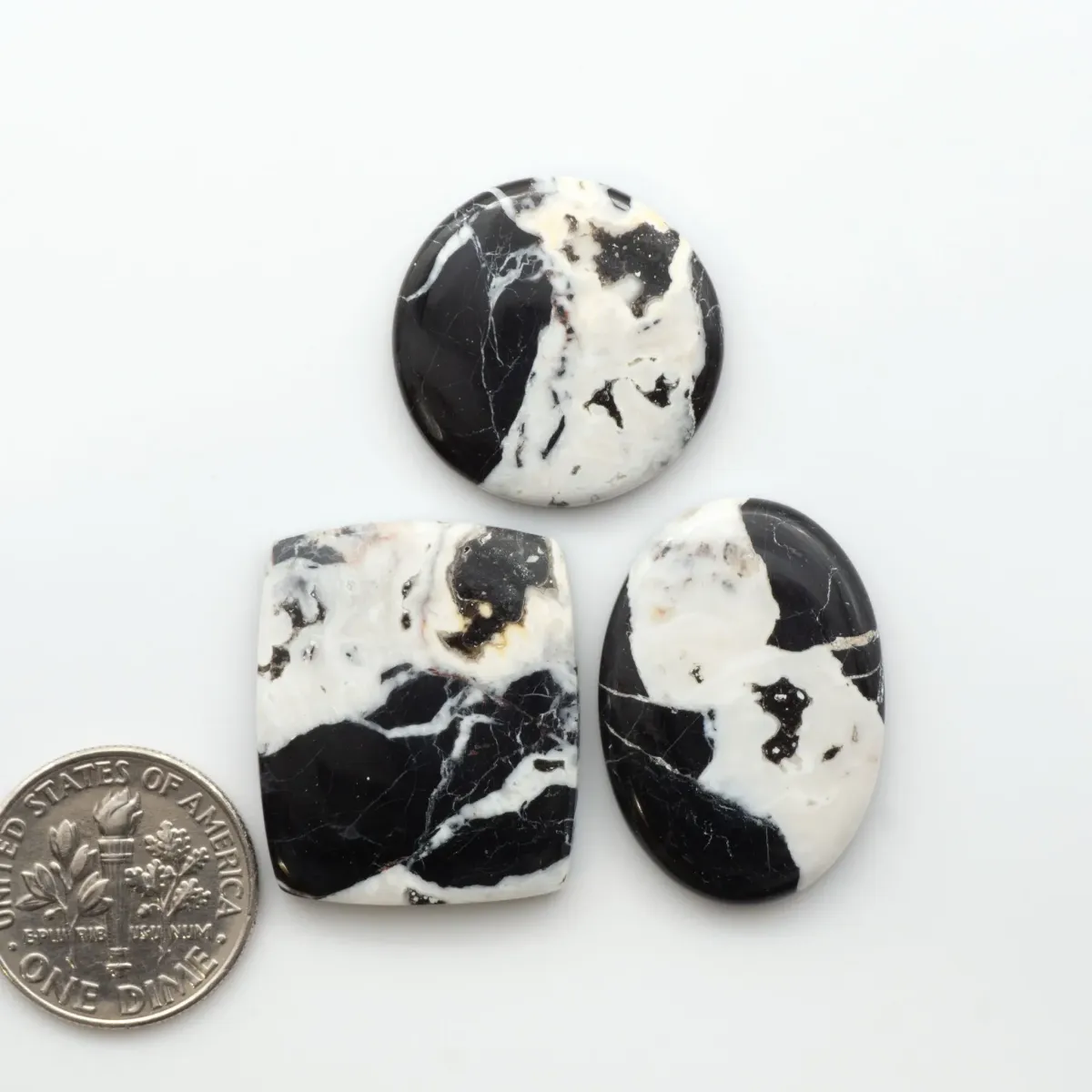
Image used with permission from
Turquoise Origins:
The Mines Behind Our Jewelry

Image used with permission from
Kings Manassa Turquoise — Colorado
The Kings Manassa mine is Colorado’s oldest and most storied turquoise source, now proudly owned and operated by the Cordova family of Manassa. Discovered in the late 1800s by a Navajo sheepherder, this mine has produced legendary green to blue-green stones with distinctive golden-brown matrix—shaped by the region’s unique mineral chemistry.
For decades, the King family worked this claim, passing down knowledge and tradition. Today, the Cordova family continues that legacy, stewarding the land and carefully selecting each stone by hand. Kings Manassa turquoise is rare, as most material was mined years ago, making every piece a true heirloom of Colorado’s high desert.
Perfect for: Featuring heritage, Cordova family stewardship, and the unique green hues of Colorado turquoise.

Image used with permission from
White Buffalo (Stone) — Nevada
White Buffalo isn’t turquoise, but it’s become a Southwest icon in its own right. This striking white stone with bold black or brown matrix is found only in a handful of claims in Nevada, now jointly stewarded by the Otteson Family and the Cordova Family of Manassa.
The stone’s discovery is credited to the Ottesons, legendary Nevada miners, but today both families work these claims, honoring a tradition of careful, small-batch extraction. Each White Buffalo stone is shaped by ancient volcanic activity and the hands of modern lapidaries—no two are exactly alike. Its bold contrast and rarity make it a favorite for artists and collectors seeking something truly different.
Perfect for: Explaining what makes White Buffalo unique, and honoring the Otteson and Cordova families’ shared stewardship and commitment to ethical mining.
More Turquoise Origins:
Stones from Other Mines
Apache Nugget Turquoise — New Mexico
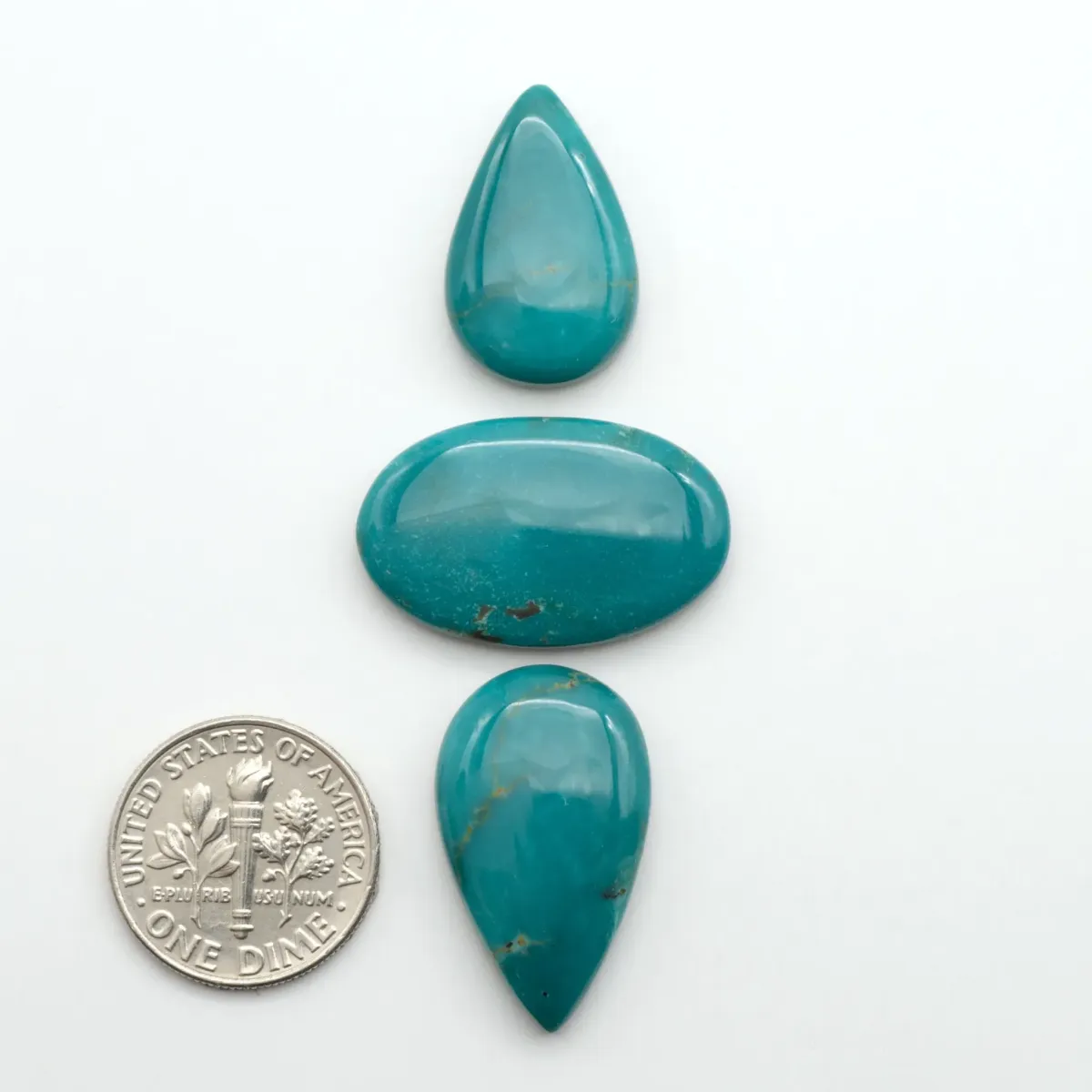
Apache Nugget turquoise is known for its rich blue-green color and bold matrix patterns. The mine is small and worked by hand, making each stone a true Southwest rarity. Apache Nugget is a favorite among collectors who value stones with vivid color and a sense of place.
Perfect for: Celebrating the artistry and rarity of New Mexico turquoise.
Black Jack Turquoise — Nevada
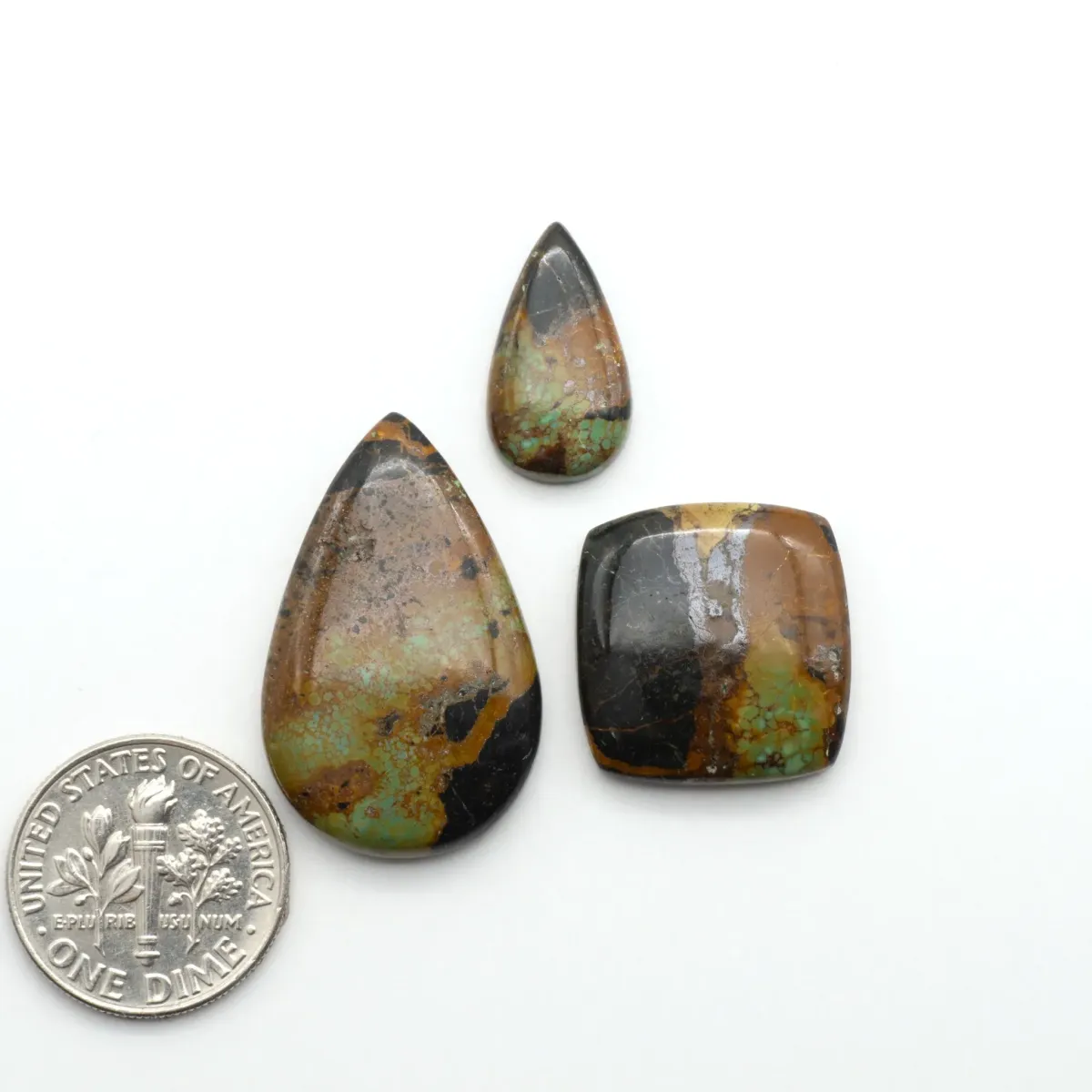
Black Jack turquoise is found in central Nevada, in a region known for its rugged beauty and mineral wealth. The mine is small and family-run, producing stones with darker blue shades and dramatic black matrix. Mining is done on a limited scale, often by hand, making Black Jack turquoise a rare find. Each piece reflects the wild, untamed landscape of Nevada’s high desert.
Perfect for: Emphasizing rarity, dramatic color, and the tradition of family mining.
Blue Moon Turquoise — Nevada
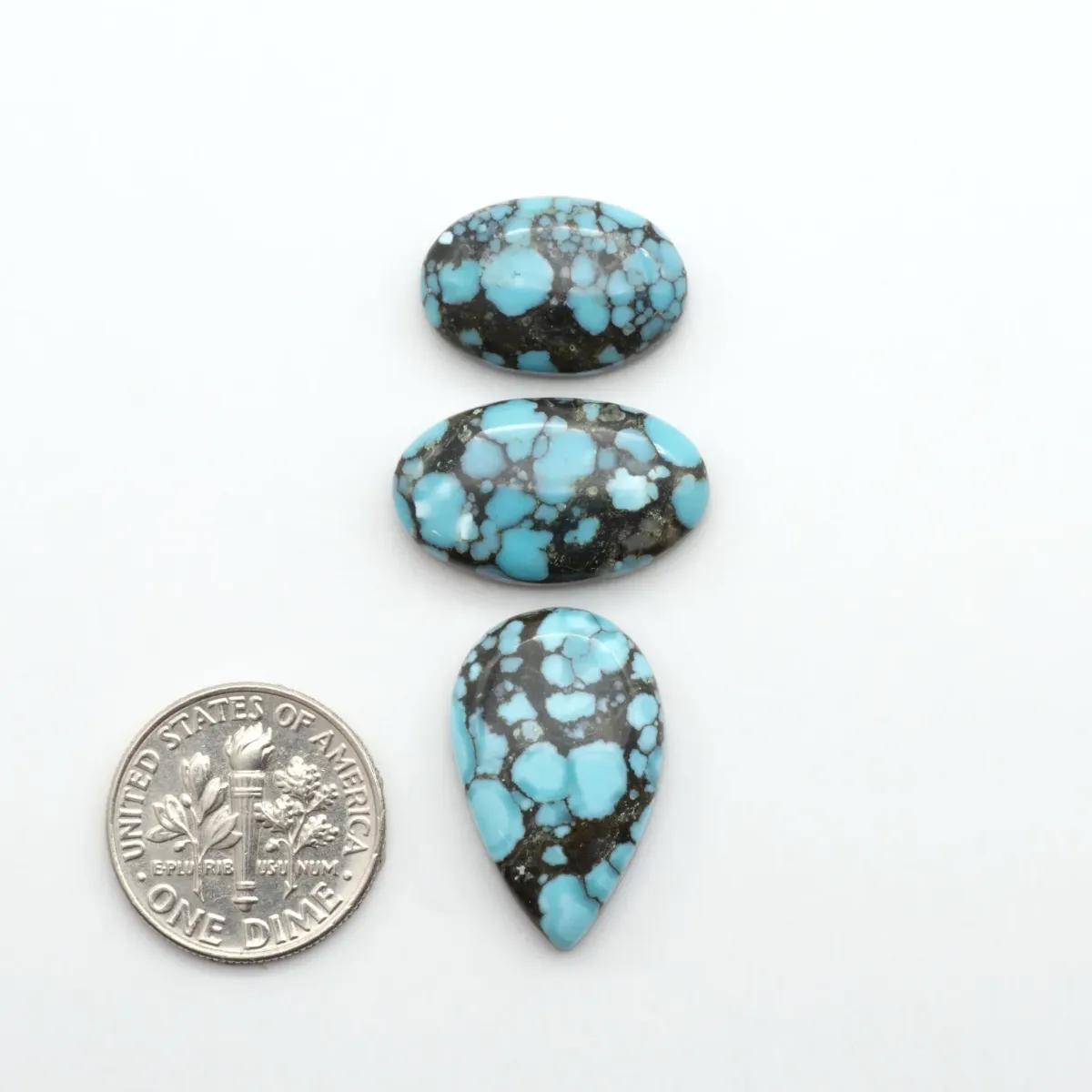
Blue Moon turquoise comes from a small, dedicated operation in Nevada’s mining country. The stones range from medium to dark blue, often with classic spiderweb matrix that forms naturally in the host rock. The mine is worked by a handful of passionate miners, and the best material is reserved for artists who value its depth and patterning. Blue Moon turquoise is a favorite for those seeking stones with character and a sense of place.
Perfect for: Celebrating the artistry and dedication of small-scale Nevada mining.
Catalina Turquoise — Nevada
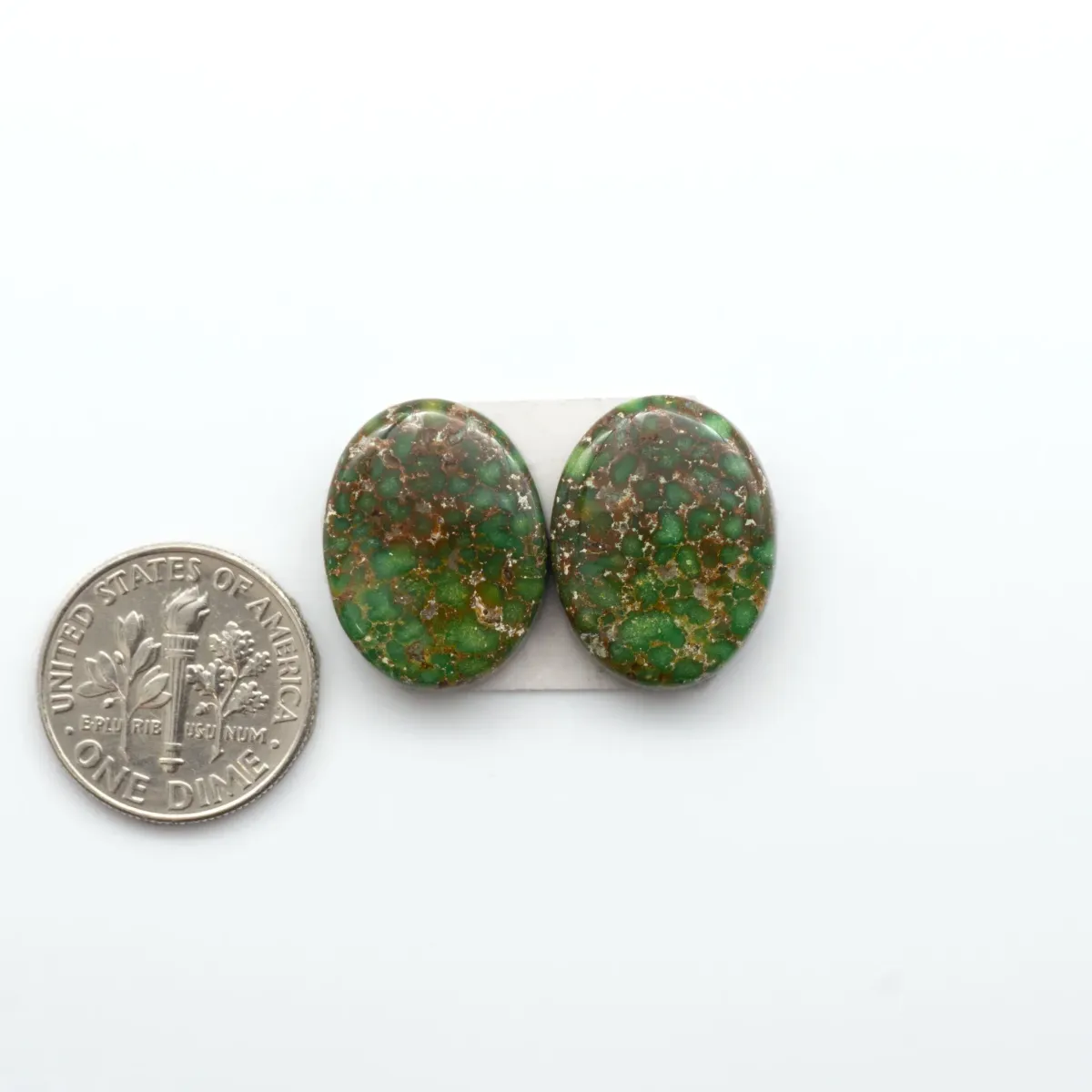
Catalina turquoise is a vibrant blue stone with brown matrix, sourced from a newer claim in western Nevada. The mine is worked by small teams who prize the material for its intense color and unique patterns. Each stone is a reflection of Nevada’s geological diversity and the spirit of discovery that drives modern turquoise mining.
Perfect for: Featuring fresh finds and the evolving story of American turquoise.
Crow Springs Turquoise — Nevada
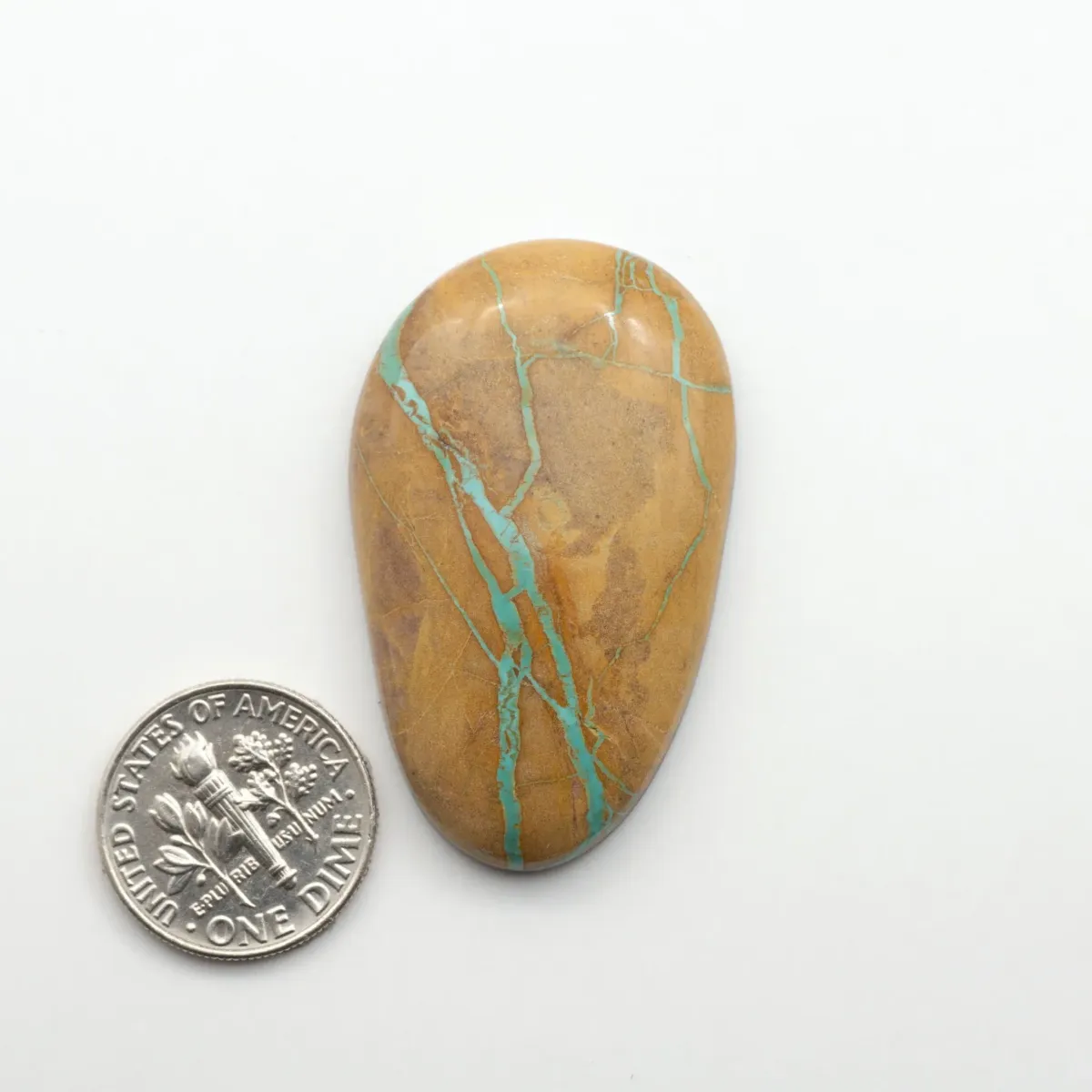
Crow Springs, near Tonopah, Nevada, is known for sky-blue stones with reddish-brown webbing. The mine has changed hands over the years, with each family adding to its legacy. Crow Springs turquoise is valued for its earthy, natural look and the sense of history that comes with every piece.
Perfect for: Telling the story of continuity and change in Nevada’s turquoise country.
Fox Turquoise — Nevada
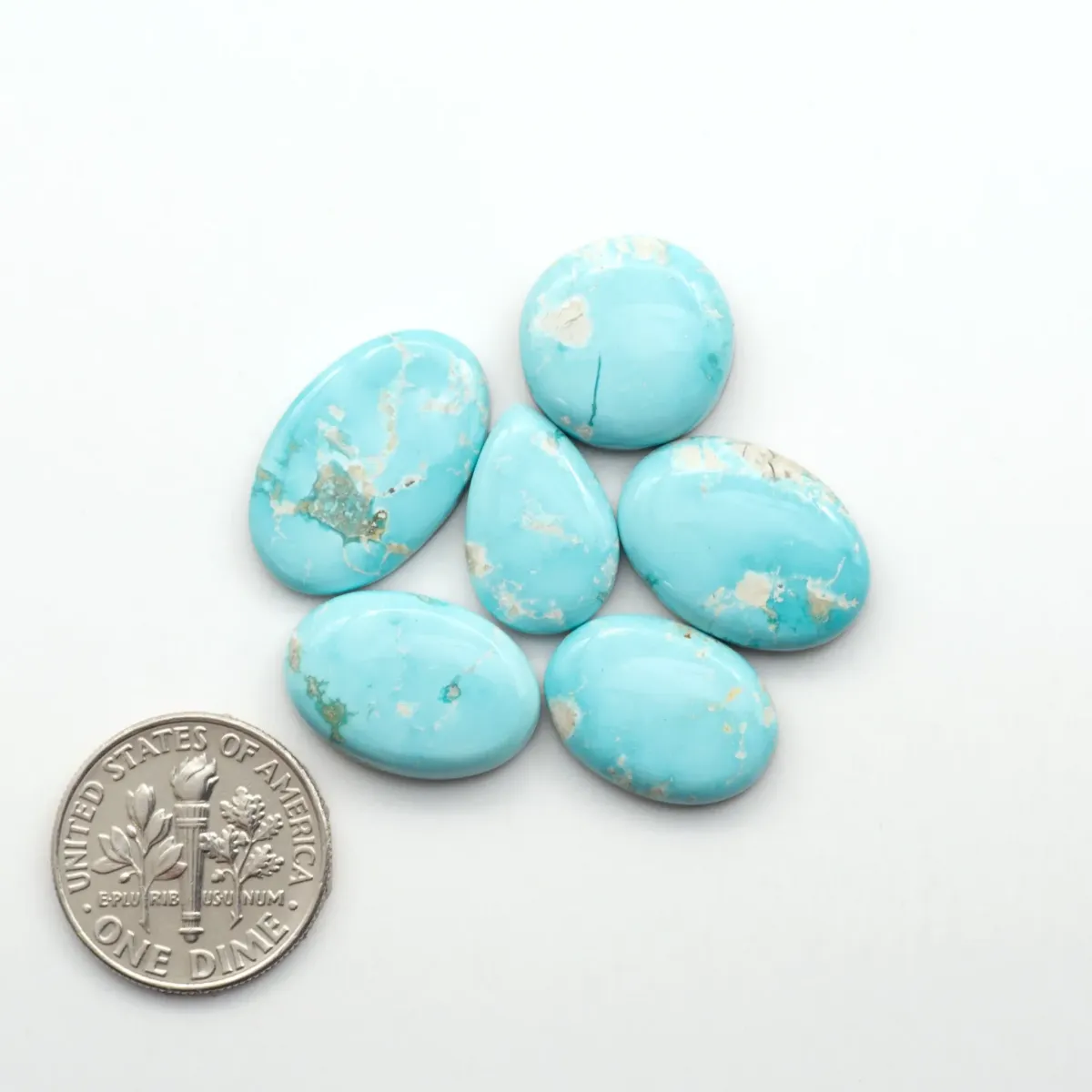
The Fox mine was once Nevada’s largest turquoise producer, supplying tons of material in the 20th century. Its stones range from soft blue to green, often with subtle matrix. Today, Fox turquoise is mostly vintage, with new material coming from small, family-worked claims. Each piece connects you to the heyday of Southwest jewelry and the enduring appeal of Nevada turquoise.
Perfect for: Sharing the legacy of classic turquoise and the value of vintage material.
Golden Hills Turquoise — Kazakhstan
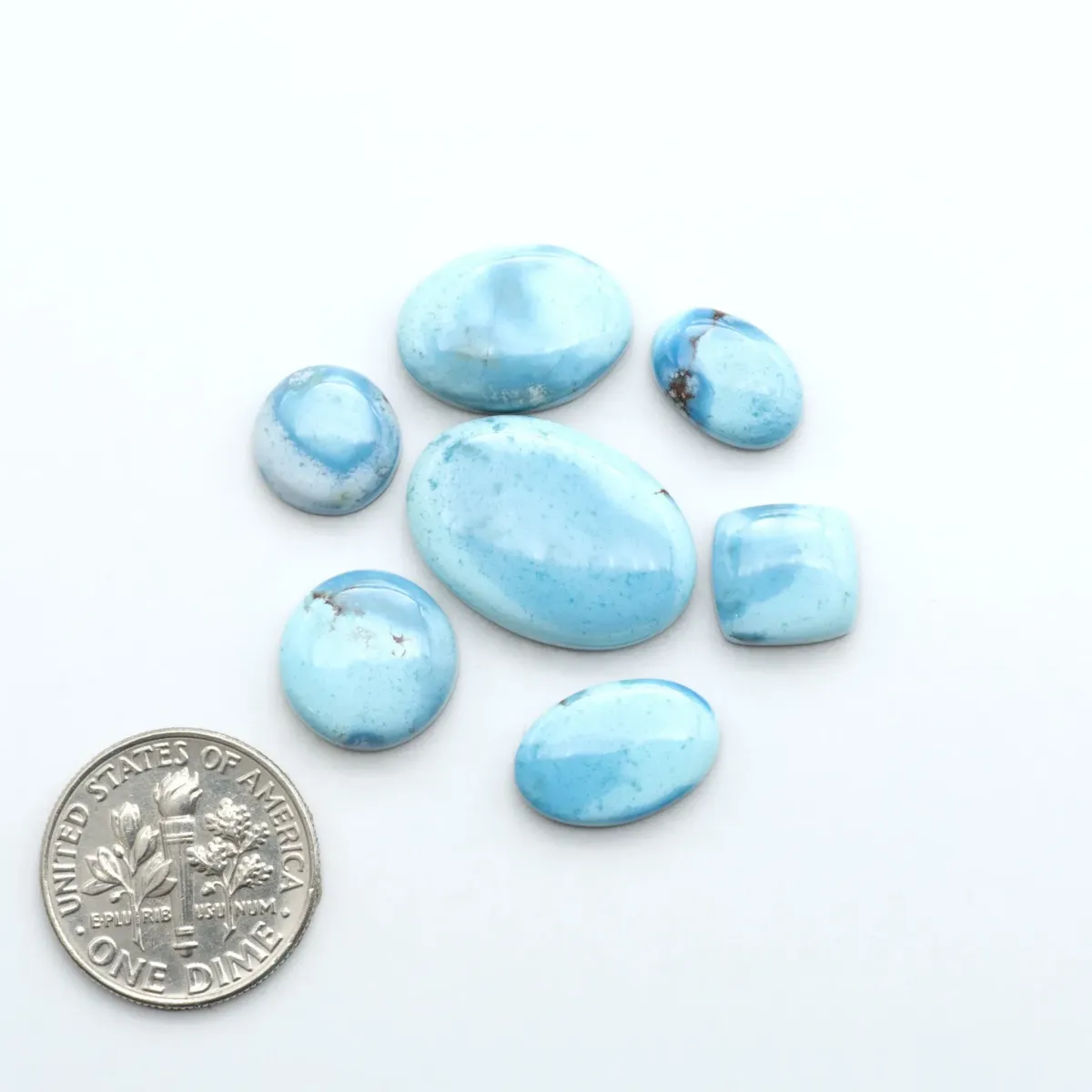
Golden Hills turquoise is instantly recognizable for its rare lavender-blue color and unique golden-brown matrix. Discovered in 2013 at the Altyn-Tyube mine in Kazakhstan, it’s mined only during the short summer season—harsh winters make access nearly impossible. The mine’s remote location and challenging conditions mean every stone is hard-won. Golden Hills turquoise has quickly become prized for its pastel hues and scarcity, offering a fresh palette for artists and collectors alike.
Perfect for: Showcasing rarity, adventure, and the global reach of turquoise.
Hubei Turquoise — Hubei Province, China
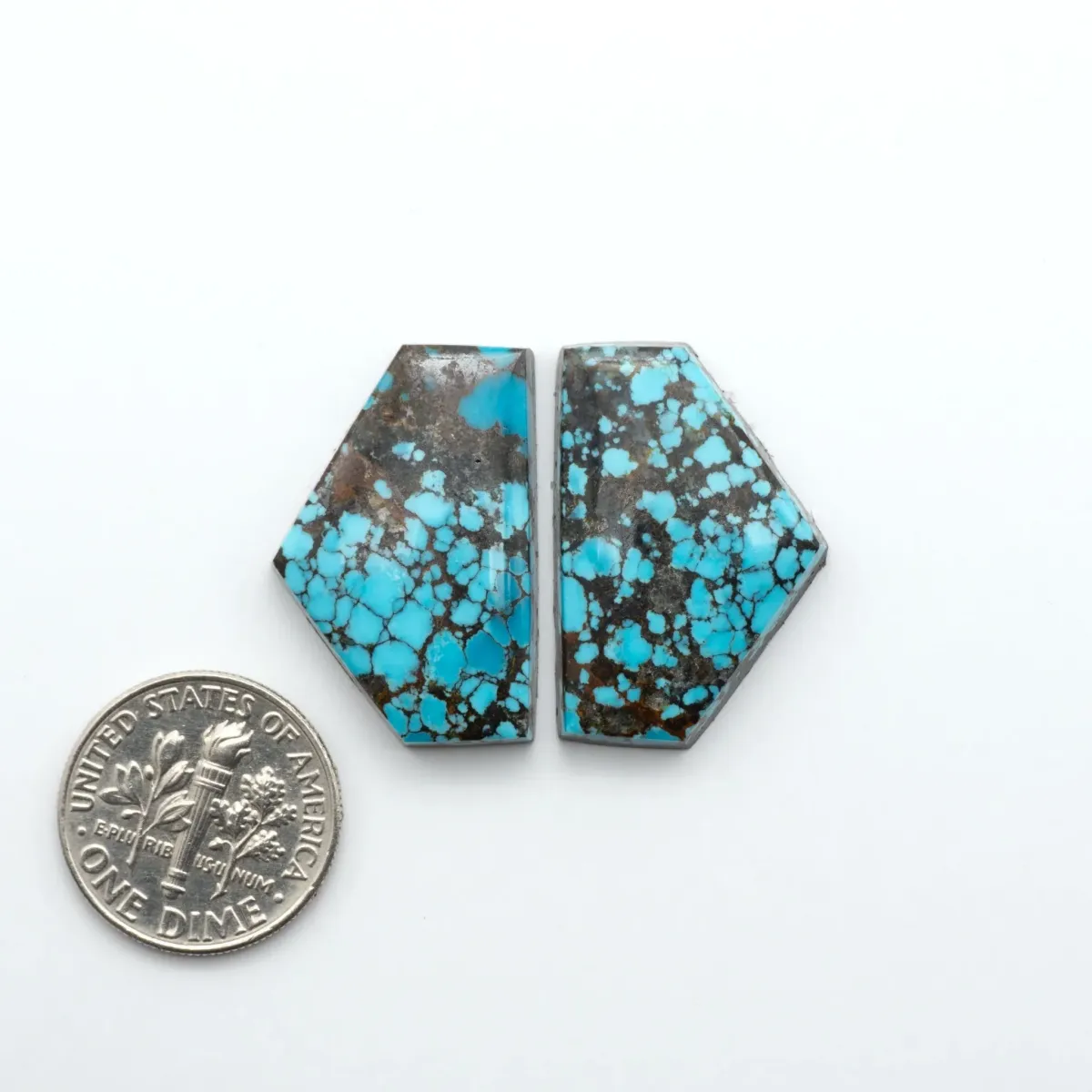
Hubei Province, in central China, has become a global turquoise powerhouse over the past 40 years. The region’s family-run mines produce everything from classic robin’s egg blue to deep green, often with dramatic spiderweb matrix. Hubei turquoise forms in ancient limestone, and the best material is still sorted and cut by hand. Many artists value Hubei for its variety and affordability, making it a staple in contemporary jewelry worldwide. The region’s turquoise is a testament to both geological diversity and the skill of generations of miners.
Perfect for: Explaining global turquoise diversity and the rise of Hubei as a collector favorite.
Ithaca Peak Turquoise — Arizona (Kingman District)
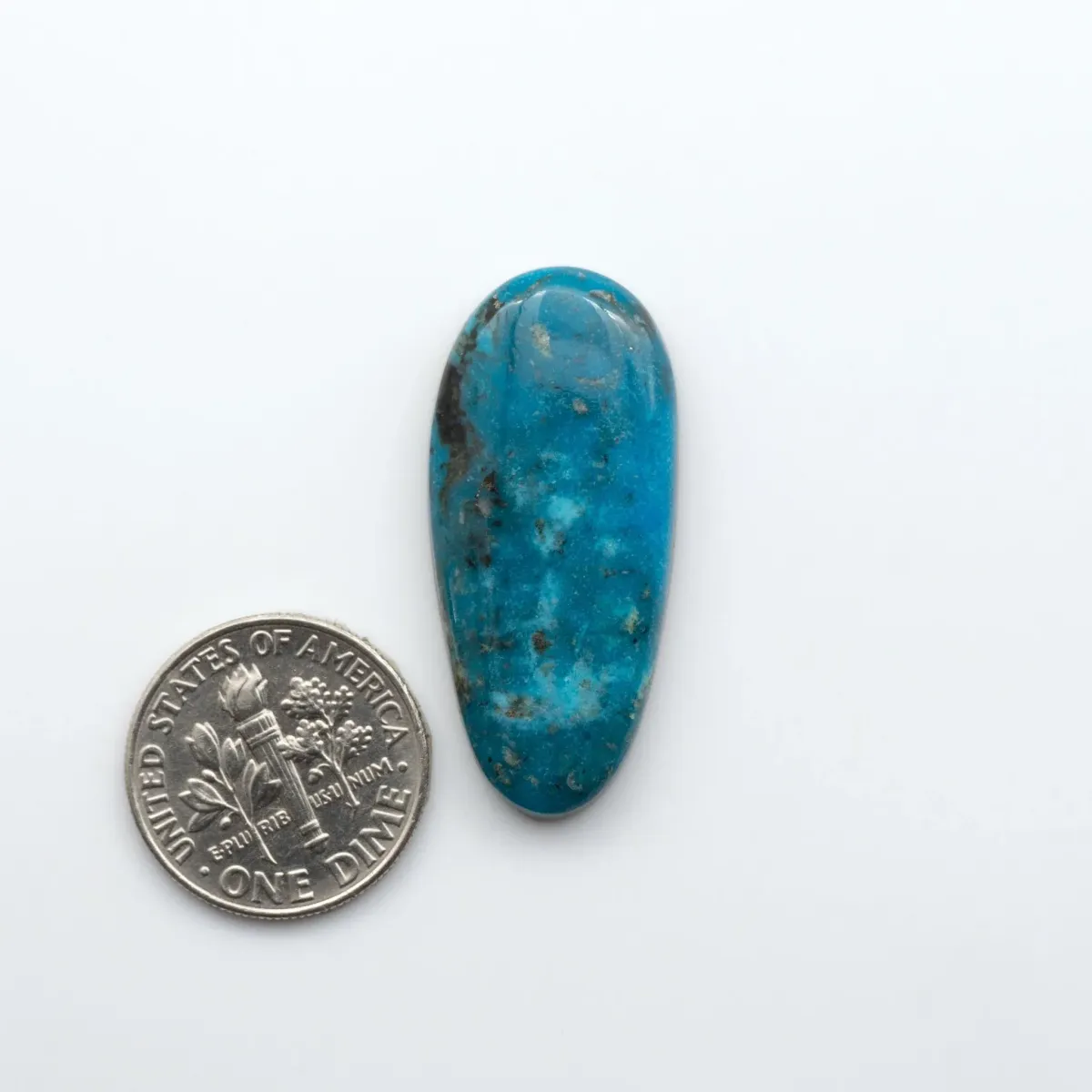
Ithaca Peak is a legendary claim within the Kingman mining district, operated by the Colbaugh family. It’s prized for its vibrant, electric blue color and the presence of pyrite or quartz matrix—giving select stones a “starry night” sparkle. The mine sits above the main Kingman workings and has produced some of the Southwest’s most collectible turquoise since the mid-20th century. Stones from Ithaca Peak are especially valued by silversmiths for their clarity and brilliance; pyrite-included pieces are rare and highly sought after.
Perfect for: Showcasing the rarity, sparkle, and legacy of Arizona turquoise.
Kingman Turquoise — Arizona
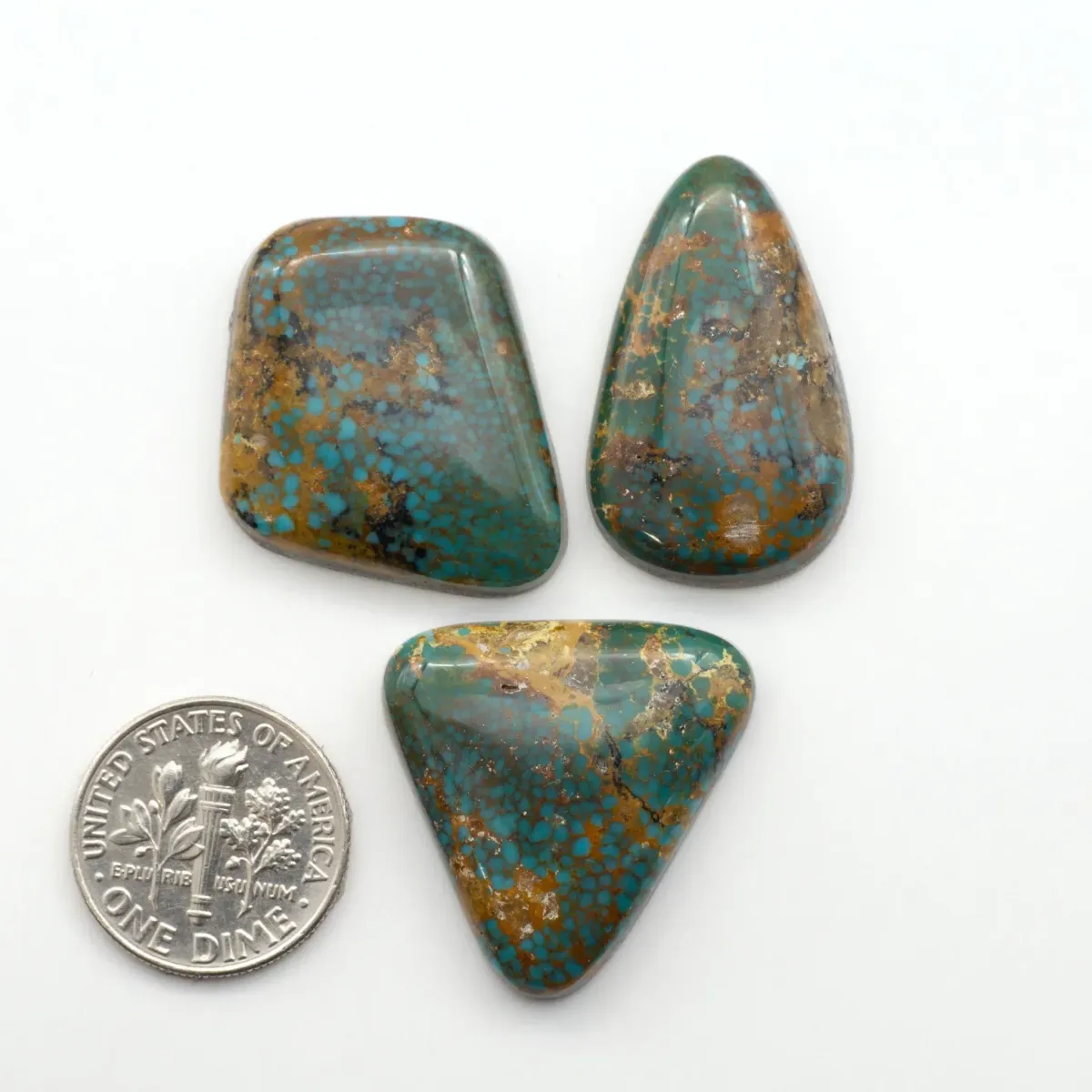
The Kingman mine, nestled in Arizona’s Cerbat Mountains, has been a cornerstone of American turquoise for over a century. Originally mined by Indigenous peoples, Kingman turquoise became commercially significant in the early 1900s and is still family-owned by the Colbaughs. The mine is famous for its range—from vivid sky blue to deep green, often with striking black or golden matrix that forms naturally in the host rock. Each stone is shaped by mineral-rich water moving through ancient volcanic rock, creating those unique web-like patterns collectors love. Kingman turquoise is one of the few American turquoises still mined at scale today, and every piece connects you to a living tradition of Southwest artistry.
Perfect for: Adding geological and historical context to Kingman pieces without overwhelming the customer.
Nacozari Turquoise — Sonora, Mexico
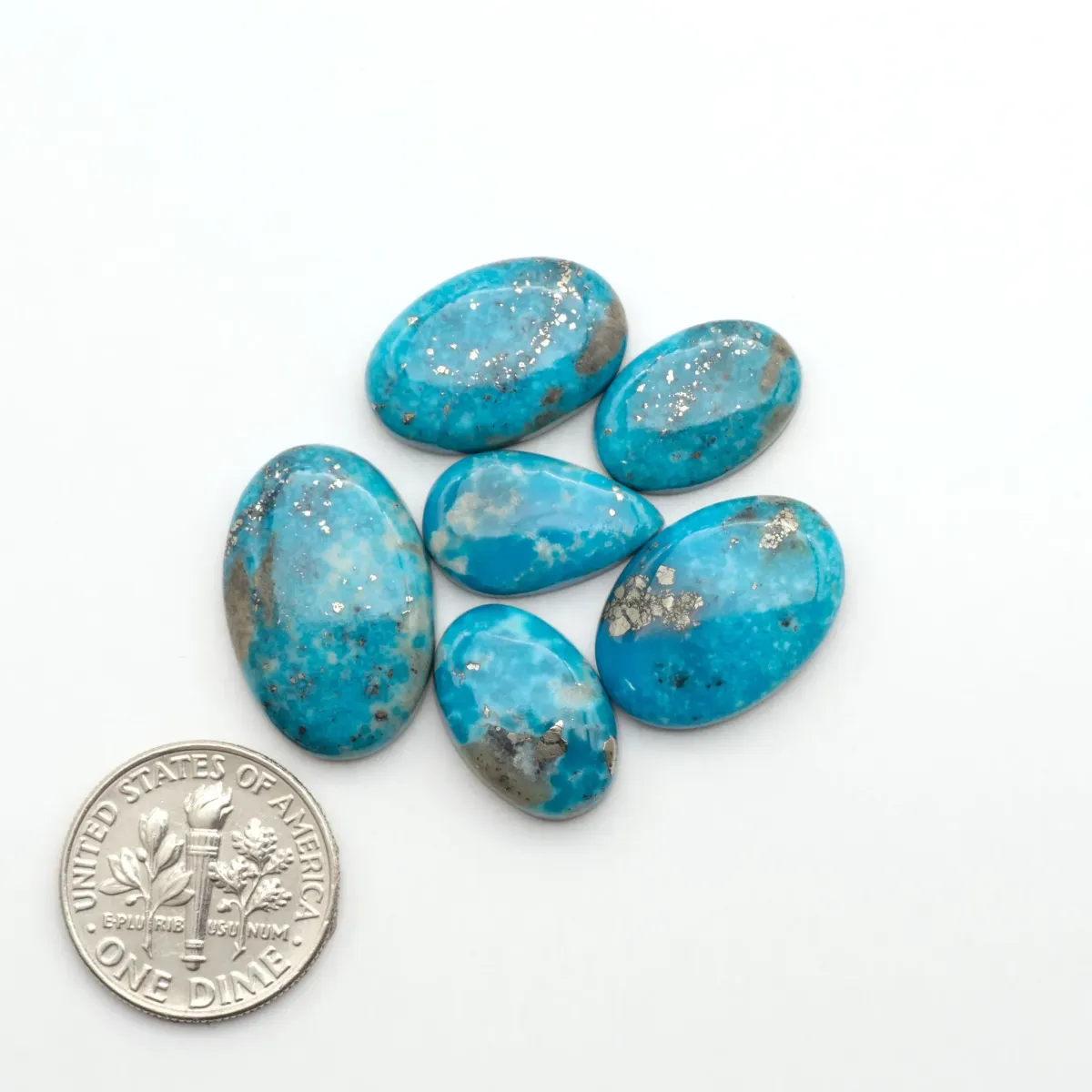
Nacozari turquoise comes from northern Mexico and is famous for its intense sky-blue color and minimal matrix. The mine is now closed, making existing stones increasingly rare and collectible. Each piece is a testament to Mexico’s turquoise heritage and the fleeting nature of the world’s finest gems.
Perfect for: Explaining rarity and the enduring appeal of classic blue turquoise.
Number 8 Turquoise — Nevada
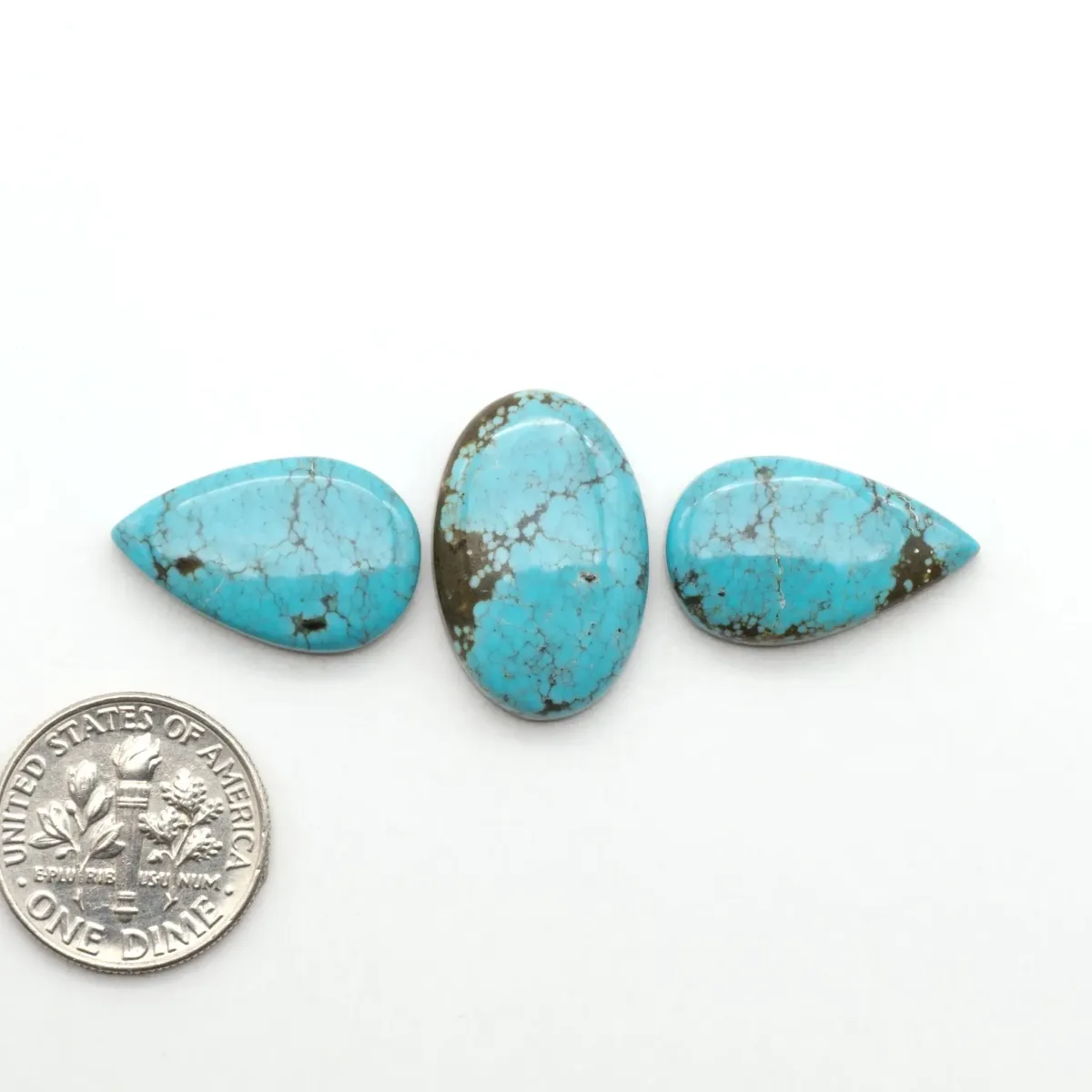
Number 8 turquoise is legendary for its intricate spiderweb matrix and a palette ranging from blue to green. The original mine closed in 1961, making any Number 8 turquoise highly collectible. Stones are sourced from old stock or reclaimed from vintage jewelry, each one a piece of American mining history.
Perfect for: Highlighting collectability, history, and the artistry of spiderweb turquoise.
Pilot Mountain Turquoise — Nevada
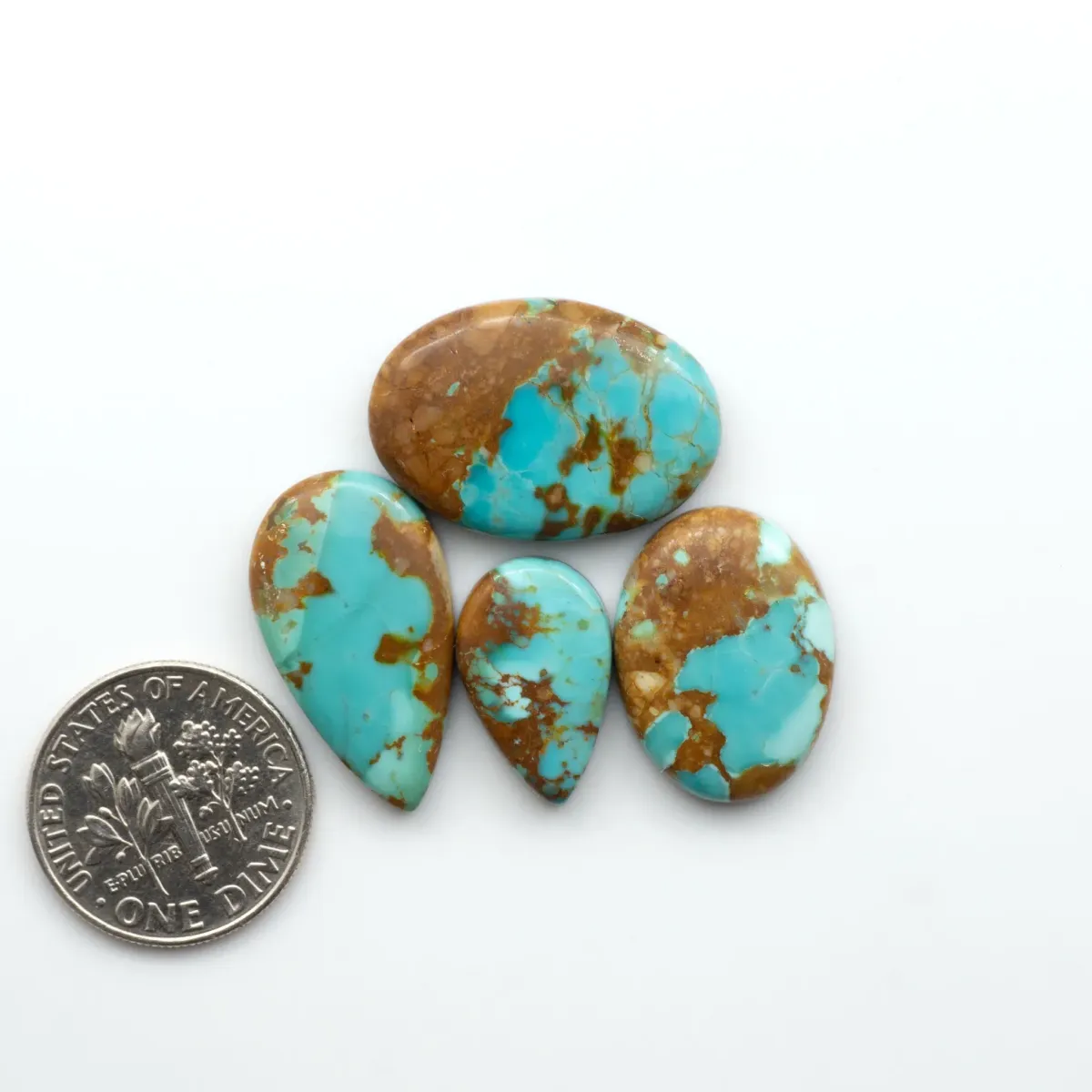
Pilot Mountain is a family-run mine near Tonopah, Nevada, operated by the Otteson family for generations. The stones are multicolored—blue and green with brown to black webbing—reflecting the complex geology of the area. Mining is done by hand, and each stone is carefully selected for its color and pattern. Pilot Mountain turquoise captures the wild spirit of Nevada’s high desert.
Perfect for: Emphasizing family tradition and the natural artistry of multicolored stones.
Royston Turquoise — Nevada
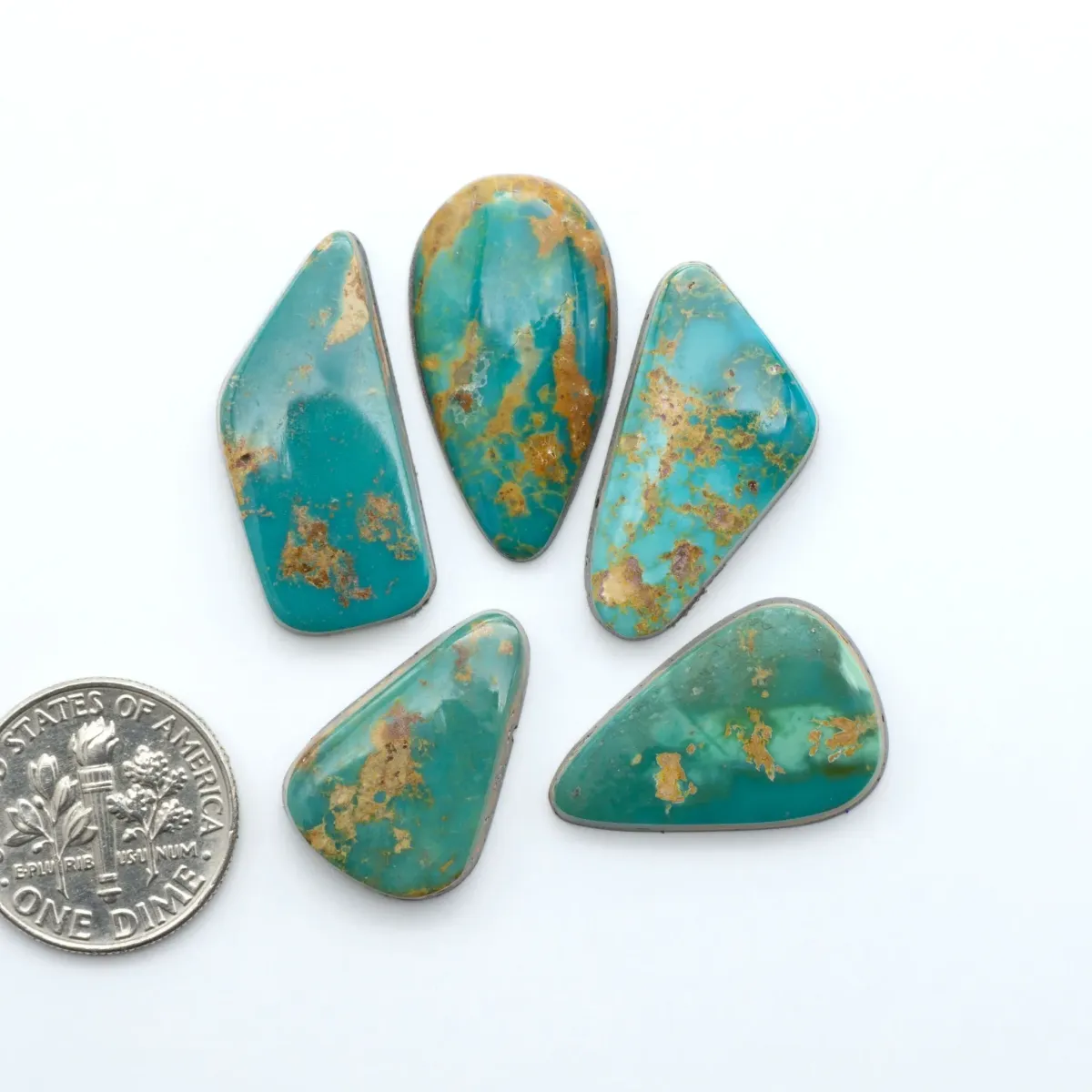
High in Nevada’s Royston Hills, this family-owned mine produces turquoise with beautiful color variations—from deep green to bright blue, often in the same stone. The Royston mine has been worked by the same family for generations, making each piece part of a continuing story. The mineral-rich environment creates stones with natural color gradations and golden-brown matrix that looks like landscape paintings. It’s turquoise that feels alive, with movement and depth that changes as light hits it.
Perfect for: Highlighting family heritage and the unique visual characteristics of Royston turquoise.
Sonoran Mountain Turquoise — Sonora, Mexico
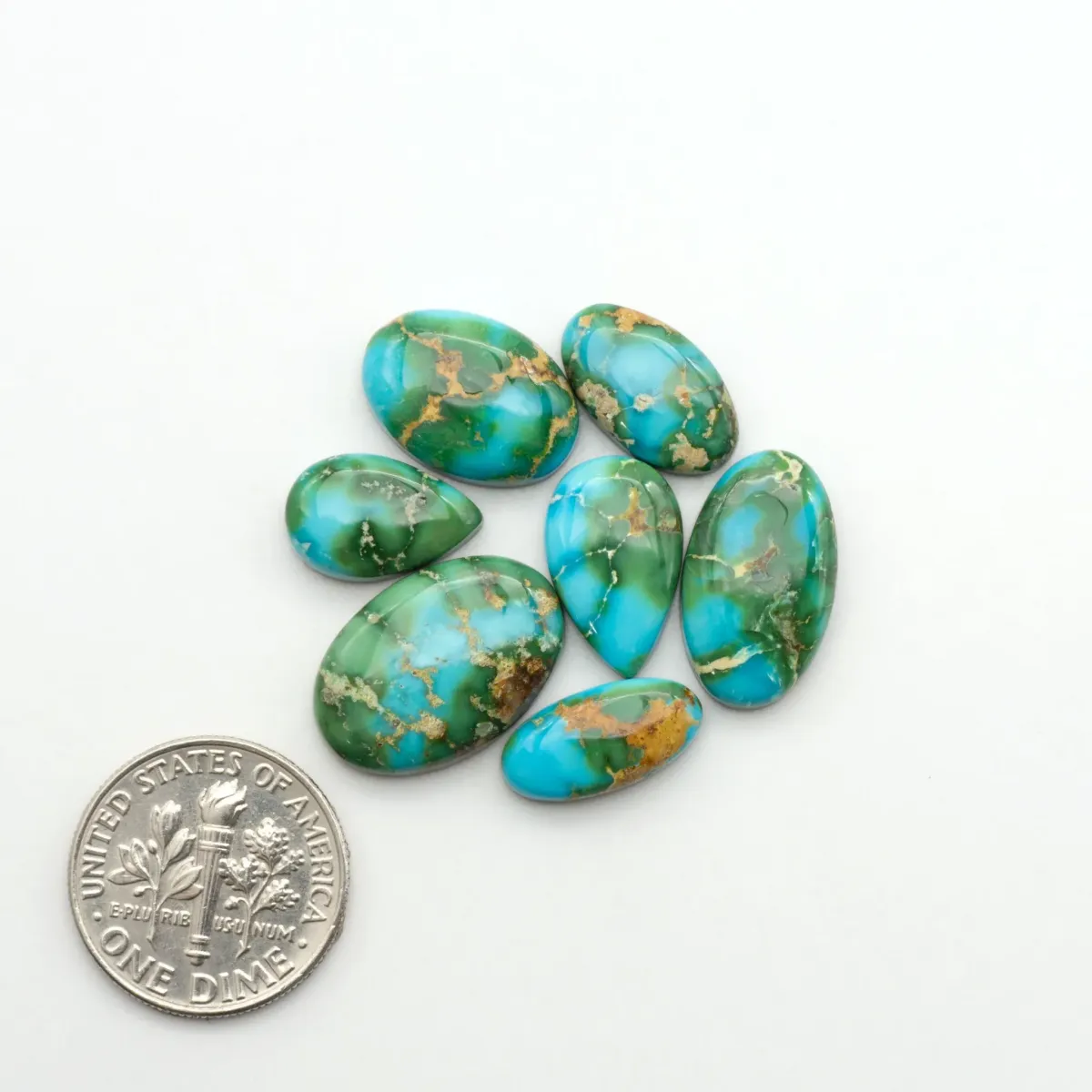
Sonoran Mountain turquoise is mined in northern Mexico and is known for its bright blue stones, often with green tones and a unique, almost “wet” look. The mine is relatively new, and each stone is hand-selected by experienced miners. Sonoran Mountain turquoise is quickly gaining popularity for its vibrant colors and fresh appeal.
Perfect for: Highlighting new discoveries and the evolving story of Mexican turquoise.
Sonoran South Hill Turquoise — Sonora, Mexico

South Hill turquoise features lively blues and greens with a softer matrix, mined from the hills around Sonora. Small-scale miners work the claim by hand, and each stone reflects the spirit of contemporary Southwest jewelry—fresh, natural, and full of color.
Perfect for: Showcasing the artistry of small-scale mining and the beauty of modern turquoise.
Spiny Kingman Turquoise — Arizona (Kingman District)
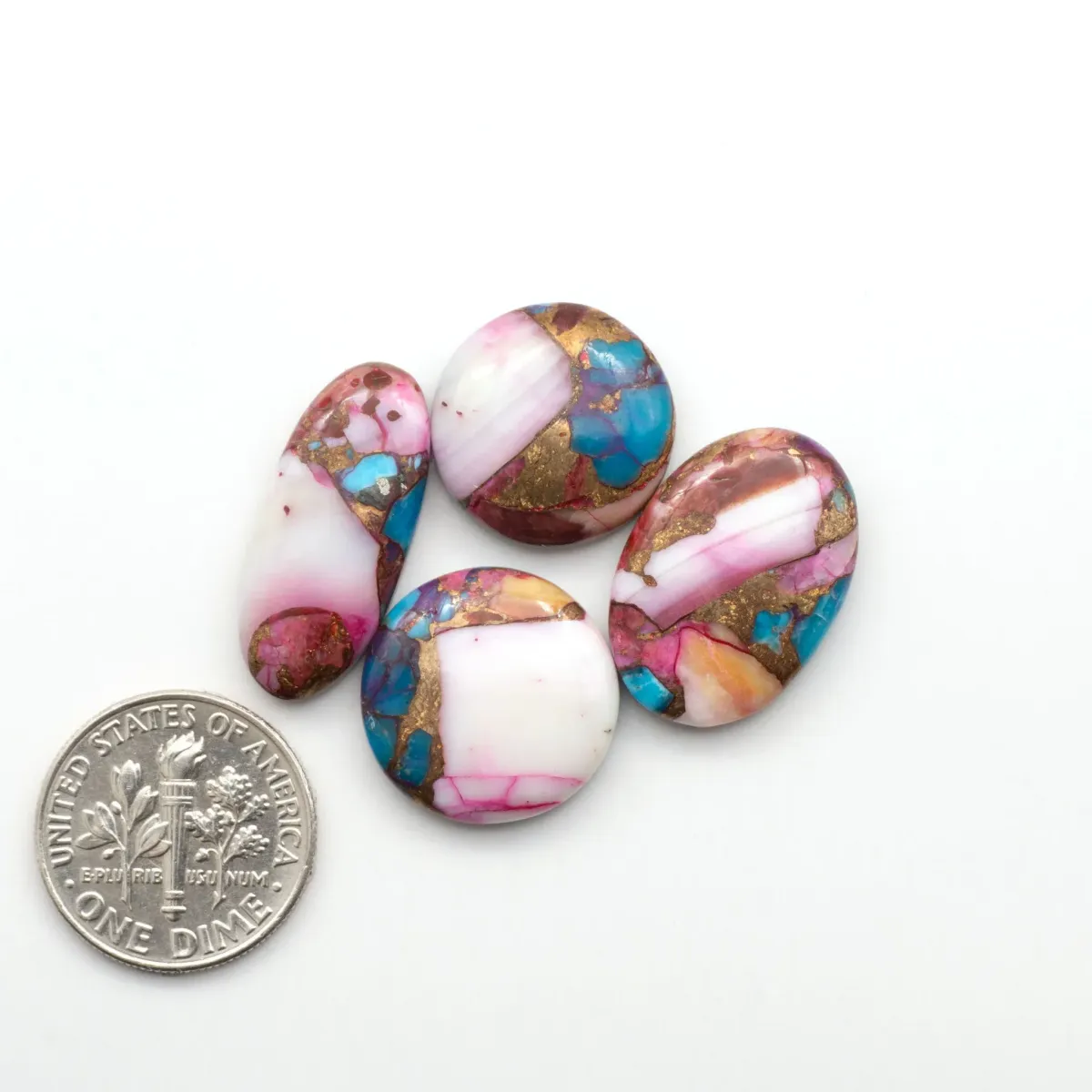
Spiny Kingman is a contemporary hybrid—Kingman turquoise fused with vibrant spiny oyster shell, a material long used by Southwest artists. This unique blend is crafted by skilled lapidaries in Arizona, celebrating both land and sea. The result is a one-of-a-kind mosaic, where every cabochon tells a fresh story while honoring ancient traditions. The combination is only possible thanks to the enduring output of the Kingman mine.
Perfect for: Highlighting modern Southwest artistry and the fusion of natural materials.
Turquoise Mountain — Arizona (Kingman District)
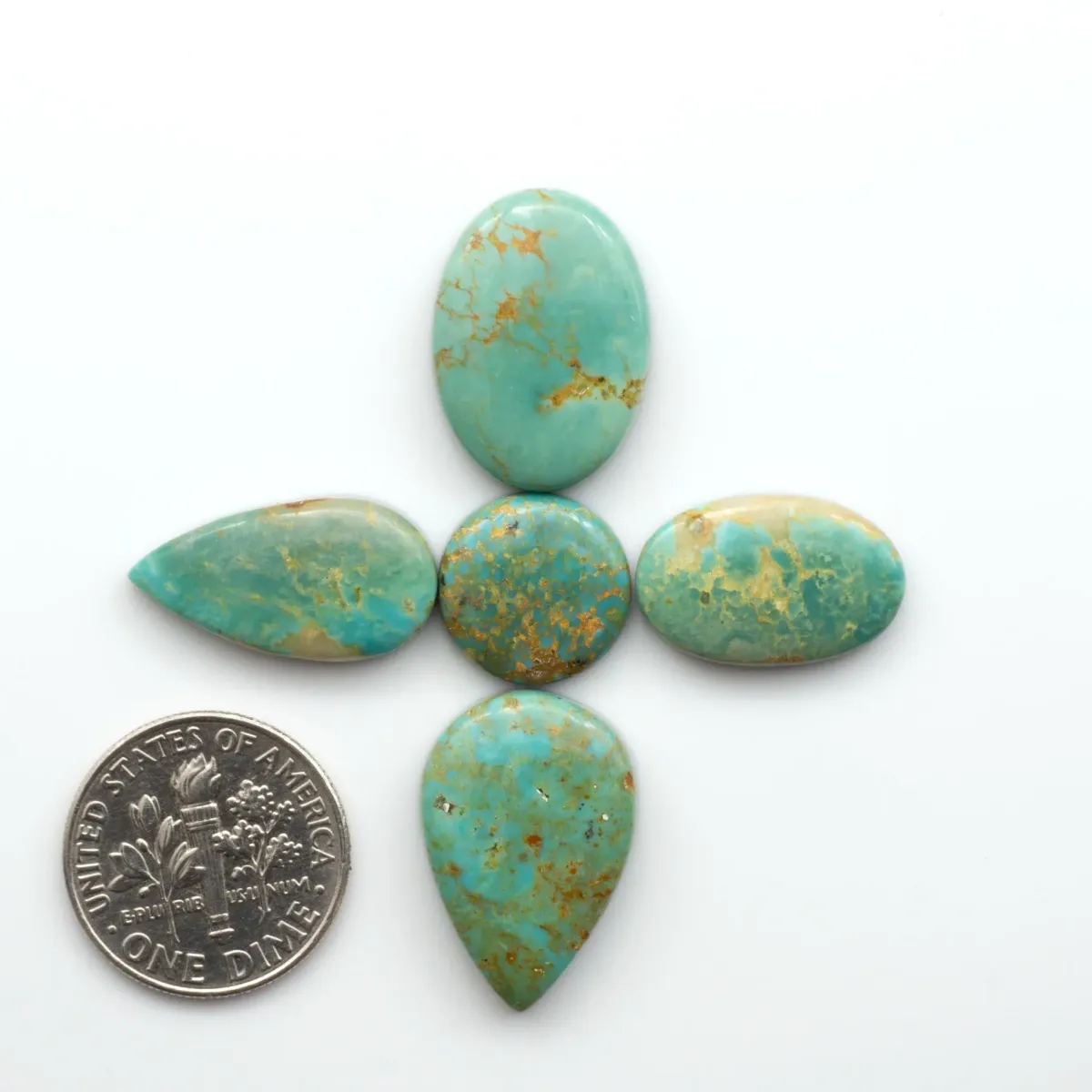
Turquoise Mountain is a historic claim adjacent to the Kingman mine, once a major supplier in the 1970s and 80s. Known for its rich blue stones with golden to brown matrix, the mine’s output is distinct—each piece a natural abstract painting. The mine is still worked on a small scale, with most material hand-selected by seasoned miners. Turquoise Mountain turquoise is a favorite among jewelers who want stones with bold, natural patterning and a classic Southwest look.
Perfect for: Telling the story of Arizona’s turquoise boom and the artistry of small-scale mining.
White Water Turquoise — Mexico
White Water turquoise is a newer discovery, mined in northern Mexico. Its signature look: brilliant blue stones with striking white matrix, reminiscent of mountain streams. The mine is worked by small crews who hand-select each piece for color and clarity. White Water turquoise is in high demand for its crisp, high-contrast appearance and limited availability. Each stone is a testament to Mexico’s growing reputation for fine turquoise.
Perfect for: Highlighting new discoveries and the artistry of hand-selected stones.
Images used with permission from Cutting Edge Turquoise
More Turquoise Origins:
Stones from Other Mines
Apache Nugget Turquoise — New Mexico

Apache Nugget turquoise is known for its rich blue-green color and bold matrix patterns. The mine is small and worked by hand, making each stone a true Southwest rarity. Apache Nugget is a favorite among collectors who value stones with vivid color and a sense of place.
Perfect for: Celebrating the artistry and rarity of New Mexico turquoise.
Black Jack Turquoise — Nevada

Black Jack turquoise is found in central Nevada, in a region known for its rugged beauty and mineral wealth. The mine is small and family-run, producing stones with darker blue shades and dramatic black matrix. Mining is done on a limited scale, often by hand, making Black Jack turquoise a rare find. Each piece reflects the wild, untamed landscape of Nevada’s high desert.
Perfect for: Emphasizing rarity, dramatic color, and the tradition of family mining.
Blue Moon Turquoise — Nevada

Blue Moon turquoise comes from a small, dedicated operation in Nevada’s mining country. The stones range from medium to dark blue, often with classic spiderweb matrix that forms naturally in the host rock. The mine is worked by a handful of passionate miners, and the best material is reserved for artists who value its depth and patterning. Blue Moon turquoise is a favorite for those seeking stones with character and a sense of place.
Perfect for: Celebrating the artistry and dedication of small-scale Nevada mining.
Catalina Turquoise — Nevada

Catalina turquoise is a vibrant blue stone with brown matrix, sourced from a newer claim in western Nevada. The mine is worked by small teams who prize the material for its intense color and unique patterns. Each stone is a reflection of Nevada’s geological diversity and the spirit of discovery that drives modern turquoise mining.
Perfect for: Featuring fresh finds and the evolving story of American turquoise.
Crow Springs Turquoise — Nevada

Crow Springs, near Tonopah, Nevada, is known for sky-blue stones with reddish-brown webbing. The mine has changed hands over the years, with each family adding to its legacy. Crow Springs turquoise is valued for its earthy, natural look and the sense of history that comes with every piece.
Perfect for: Telling the story of continuity and change in Nevada’s turquoise country.
Fox Turquoise — Nevada

The Fox mine was once Nevada’s largest turquoise producer, supplying tons of material in the 20th century. Its stones range from soft blue to green, often with subtle matrix. Today, Fox turquoise is mostly vintage, with new material coming from small, family-worked claims. Each piece connects you to the heyday of Southwest jewelry and the enduring appeal of Nevada turquoise.
Perfect for: Sharing the legacy of classic turquoise and the value of vintage material.
Golden Hills Turquoise — Kazakhstan

Golden Hills turquoise is instantly recognizable for its rare lavender-blue color and unique golden-brown matrix. Discovered in 2013 at the Altyn-Tyube mine in Kazakhstan, it’s mined only during the short summer season—harsh winters make access nearly impossible. The mine’s remote location and challenging conditions mean every stone is hard-won. Golden Hills turquoise has quickly become prized for its pastel hues and scarcity, offering a fresh palette for artists and collectors alike.
Perfect for: Showcasing rarity, adventure, and the global reach of turquoise.
Hubei Turquoise — Hubei Province, China

Hubei Province, in central China, has become a global turquoise powerhouse over the past 40 years. The region’s family-run mines produce everything from classic robin’s egg blue to deep green, often with dramatic spiderweb matrix. Hubei turquoise forms in ancient limestone, and the best material is still sorted and cut by hand. Many artists value Hubei for its variety and affordability, making it a staple in contemporary jewelry worldwide. The region’s turquoise is a testament to both geological diversity and the skill of generations of miners.
Perfect for: Explaining global turquoise diversity and the rise of Hubei as a collector favorite.
Ithaca Peak Turquoise — Arizona (Kingman District)

Ithaca Peak is a legendary claim within the Kingman mining district, operated by the Colbaugh family. It’s prized for its vibrant, electric blue color and the presence of pyrite or quartz matrix—giving select stones a “starry night” sparkle. The mine sits above the main Kingman workings and has produced some of the Southwest’s most collectible turquoise since the mid-20th century. Stones from Ithaca Peak are especially valued by silversmiths for their clarity and brilliance; pyrite-included pieces are rare and highly sought after.
Perfect for: Showcasing the rarity, sparkle, and legacy of Arizona turquoise.
Kingman Turquoise — Arizona

The Kingman mine, nestled in Arizona’s Cerbat Mountains, has been a cornerstone of American turquoise for over a century. Originally mined by Indigenous peoples, Kingman turquoise became commercially significant in the early 1900s and is still family-owned by the Colbaughs. The mine is famous for its range—from vivid sky blue to deep green, often with striking black or golden matrix that forms naturally in the host rock. Each stone is shaped by mineral-rich water moving through ancient volcanic rock, creating those unique web-like patterns collectors love. Kingman turquoise is one of the few American turquoises still mined at scale today, and every piece connects you to a living tradition of Southwest artistry.
Perfect for: Adding geological and historical context to Kingman pieces without overwhelming the customer.
Nacozari Turquoise — Sonora, Mexico

Nacozari turquoise comes from northern Mexico and is famous for its intense sky-blue color and minimal matrix. The mine is now closed, making existing stones increasingly rare and collectible. Each piece is a testament to Mexico’s turquoise heritage and the fleeting nature of the world’s finest gems.
Perfect for: Explaining rarity and the enduring appeal of classic blue turquoise.
Number 8 Turquoise — Nevada

Number 8 turquoise is legendary for its intricate spiderweb matrix and a palette ranging from blue to green. The original mine closed in 1961, making any Number 8 turquoise highly collectible. Stones are sourced from old stock or reclaimed from vintage jewelry, each one a piece of American mining history.
Perfect for: Highlighting collectability, history, and the artistry of spiderweb turquoise.
Pilot Mountain Turquoise — Nevada

Pilot Mountain is a family-run mine near Tonopah, Nevada, operated by the Otteson family for generations. The stones are multicolored—blue and green with brown to black webbing—reflecting the complex geology of the area. Mining is done by hand, and each stone is carefully selected for its color and pattern. Pilot Mountain turquoise captures the wild spirit of Nevada’s high desert.
Perfect for: Emphasizing family tradition and the natural artistry of multicolored stones.
Royston Turquoise — Nevada

High in Nevada’s Royston Hills, this family-owned mine produces turquoise with beautiful color variations—from deep green to bright blue, often in the same stone. The Royston mine has been worked by the same family for generations, making each piece part of a continuing story. The mineral-rich environment creates stones with natural color gradations and golden-brown matrix that looks like landscape paintings. It’s turquoise that feels alive, with movement and depth that changes as light hits it.
Perfect for: Highlighting family heritage and the unique visual characteristics of Royston turquoise.
Sonoran Mountain Turquoise — Sonora, Mexico

Sonoran Mountain turquoise is mined in northern Mexico and is known for its bright blue stones, often with green tones and a unique, almost “wet” look. The mine is relatively new, and each stone is hand-selected by experienced miners. Sonoran Mountain turquoise is quickly gaining popularity for its vibrant colors and fresh appeal.
Perfect for: Highlighting new discoveries and the evolving story of Mexican turquoise.
Sonoran South Hill Turquoise — Sonora, Mexico

South Hill turquoise features lively blues and greens with a softer matrix, mined from the hills around Sonora. Small-scale miners work the claim by hand, and each stone reflects the spirit of contemporary Southwest jewelry—fresh, natural, and full of color.
Perfect for: Showcasing the artistry of small-scale mining and the beauty of modern turquoise.
Spiny Kingman Turquoise — Arizona (Kingman District)

Spiny Kingman is a contemporary hybrid—Kingman turquoise fused with vibrant spiny oyster shell, a material long used by Southwest artists. This unique blend is crafted by skilled lapidaries in Arizona, celebrating both land and sea. The result is a one-of-a-kind mosaic, where every cabochon tells a fresh story while honoring ancient traditions. The combination is only possible thanks to the enduring output of the Kingman mine.
Perfect for: Highlighting modern Southwest artistry and the fusion of natural materials.
Turquoise Mountain — Arizona (Kingman District)

Turquoise Mountain is a historic claim adjacent to the Kingman mine, once a major supplier in the 1970s and 80s. Known for its rich blue stones with golden to brown matrix, the mine’s output is distinct—each piece a natural abstract painting. The mine is still worked on a small scale, with most material hand-selected by seasoned miners. Turquoise Mountain turquoise is a favorite among jewelers who want stones with bold, natural patterning and a classic Southwest look.
Perfect for: Telling the story of Arizona’s turquoise boom and the artistry of small-scale mining.
White Water Turquoise — Mexico
White Water turquoise is a newer discovery, mined in northern Mexico. Its signature look: brilliant blue stones with striking white matrix, reminiscent of mountain streams. The mine is worked by small crews who hand-select each piece for color and clarity. White Water turquoise is in high demand for its crisp, high-contrast appearance and limited availability. Each stone is a testament to Mexico’s growing reputation for fine turquoise.
Perfect for: Highlighting new discoveries and the artistry of hand-selected stones.
Images used with permission from Cutting Edge Turquoise
Other Gemstone Origin Stories
Lapis Lazuli — Afghanistan, Chile
Lapis lazuli is one of the world’s oldest gemstones, treasured since ancient Egypt for its deep royal blue color and flecks of golden pyrite. Afghanistan’s Badakhshan mines have been worked for over 6,000 years—families still mine the same rugged hills today. Chilean lapis is lighter, but every piece carries a sense of history and artistry. Lapis was ground for ultramarine pigment in Renaissance paintings and worn as jewelry by pharaohs and queens.
Perfect for: Adding a sense of history, artistry, and global connection to lapis pieces.
Wild Horse (Magnesite/Jasper) — Arizona
Wild Horse is a unique blend of magnesite and jasper, found only in southern Arizona. Its white base with swirling brown to maroon matrix looks like wild mustangs running across the desert—hence the name. Discovered in the 1990s, all known material comes from one small claim near Globe, Arizona. Each stone is a natural work of art, shaped by millions of years of geology and the hands of modern miners.
Perfect for: Sharing the rarity and visual drama of Wild Horse stones.
Malachite — Congo, Namibia, Russia
Malachite’s rich green bands are instantly recognizable. Congo and Namibia produce most of today’s gem malachite, often by small artisanal miners. Russian malachite once adorned palaces and cathedrals, including the famous Hermitage in St. Petersburg. Each stone’s swirling patterns are totally unique—a testament to mineral-rich water shaping copper ore over millennia.
Perfect for: Explaining the artistry of nature and the global journey of malachite.
Larimar — Dominican Republic
Larimar is found in just one place—a single mountainside in the Dominican Republic. Its soft blue and white “Caribbean” patterns evoke tropical waters and sky. Discovered in 1974 by a local, larimar is mined by hand in small tunnels. Each stone is a rare slice of island beauty, shaped by volcanic activity and the dreams of generations.
Perfect for: Adding a sense of place, rarity, and island magic to larimar jewelry.
Coral Cabochons — Mediterranean, Pacific
Coral cabochons are organic treasures, formed by the skeletons of ancient sea creatures. Mediterranean red coral has been traded for thousands of years, especially by Italian and Greek artisans. Pink and orange coral often comes from the Pacific, harvested by hand by local divers. Today, responsible sourcing is key to coral conservation, and every piece connects you to the living ocean.t.
Perfect for: Sharing the story of ocean heritage and the importance of ethical sourcing.
Charite (Charoite) — Russia
Charoite is a rare purple gemstone found only in Siberia, Russia. Its swirling patterns and vibrant color were first discovered in the 1940s but only became known to the West in the 1970s. Each cabochon looks like a miniature abstract painting—nature’s own work of art, formed in the depths of the earth.
Perfect for: Highlighting rarity, artistry, and the wonder of natural gemstones.
Spiny Oyster Shell — Sea of Cortez, Mexico
Spiny oyster shell comes from the warm waters of the Sea of Cortez. Used by Southwest jewelers for centuries, its vibrant orange, purple, and red hues add a pop of color and history. Harvesting is still done by hand, often by local divers, and each shell tells the story of the sea and the hands that brought it to shore.
Perfect for: Adding color, heritage, and oceanic storytelling to your jewelry.
Bloody Bison Jasper — USA
Bloody Bison Jasper is a bold, earthy stone with deep red and brown tones, found in the American West. Each piece is unique, with patterns reminiscent of wild landscapes and roaming herds. The stone is shaped by ancient geological processes and the hands of modern lapidaries.
Perfect for: Sharing the drama and wild spirit of the American landscape.
Magnesite — Worldwide
Magnesite is a white stone found worldwide, often dyed to mimic turquoise. Natural magnesite has a soft, chalky appearance and is valued for its versatility in jewelry making. It’s a blank canvas for artists and a testament to the creativity of jewelers around the globe.
Perfect for: Explaining versatility, artistry, and the global reach of jewelry materials.
Images used with permission from Cutting Edge Turquoise
Other Gemstone Origin Stories
Lapis Lazuli — Afghanistan, Chile
Lapis lazuli is one of the world’s oldest gemstones, treasured since ancient Egypt for its deep royal blue color and flecks of golden pyrite. Afghanistan’s Badakhshan mines have been worked for over 6,000 years—families still mine the same rugged hills today. Chilean lapis is lighter, but every piece carries a sense of history and artistry. Lapis was ground for ultramarine pigment in Renaissance paintings and worn as jewelry by pharaohs and queens.
Perfect for: Adding a sense of history, artistry, and global connection to lapis pieces.
Wild Horse (Magnesite/Jasper) — Arizona
Wild Horse is a unique blend of magnesite and jasper, found only in southern Arizona. Its white base with swirling brown to maroon matrix looks like wild mustangs running across the desert—hence the name. Discovered in the 1990s, all known material comes from one small claim near Globe, Arizona. Each stone is a natural work of art, shaped by millions of years of geology and the hands of modern miners.
Perfect for: Sharing the rarity and visual drama of Wild Horse stones.
Malachite — Congo, Namibia, Russia
Malachite’s rich green bands are instantly recognizable. Congo and Namibia produce most of today’s gem malachite, often by small artisanal miners. Russian malachite once adorned palaces and cathedrals, including the famous Hermitage in St. Petersburg. Each stone’s swirling patterns are totally unique—a testament to mineral-rich water shaping copper ore over millennia.
Perfect for: Explaining the artistry of nature and the global journey of malachite.
Larimar — Dominican Republic
Larimar is found in just one place—a single mountainside in the Dominican Republic. Its soft blue and white “Caribbean” patterns evoke tropical waters and sky. Discovered in 1974 by a local, larimar is mined by hand in small tunnels. Each stone is a rare slice of island beauty, shaped by volcanic activity and the dreams of generations.
Perfect for: Adding a sense of place, rarity, and island magic to larimar jewelry.
Coral Cabochons — Mediterranean, Pacific
Coral cabochons are organic treasures, formed by the skeletons of ancient sea creatures. Mediterranean red coral has been traded for thousands of years, especially by Italian and Greek artisans. Pink and orange coral often comes from the Pacific, harvested by hand by local divers. Today, responsible sourcing is key to coral conservation, and every piece connects you to the living ocean.t.
Perfect for: Sharing the story of ocean heritage and the importance of ethical sourcing.
Charite (Charoite) — Russia
Charoite is a rare purple gemstone found only in Siberia, Russia. Its swirling patterns and vibrant color were first discovered in the 1940s but only became known to the West in the 1970s. Each cabochon looks like a miniature abstract painting—nature’s own work of art, formed in the depths of the earth.
Perfect for: Highlighting rarity, artistry, and the wonder of natural gemstones.
Spiny Oyster Shell — Sea of Cortez, Mexico
Spiny oyster shell comes from the warm waters of the Sea of Cortez. Used by Southwest jewelers for centuries, its vibrant orange, purple, and red hues add a pop of color and history. Harvesting is still done by hand, often by local divers, and each shell tells the story of the sea and the hands that brought it to shore.
Perfect for: Adding color, heritage, and oceanic storytelling to your jewelry.
Bloody Bison Jasper — USA
Bloody Bison Jasper is a bold, earthy stone with deep red and brown tones, found in the American West. Each piece is unique, with patterns reminiscent of wild landscapes and roaming herds. The stone is shaped by ancient geological processes and the hands of modern lapidaries.
Perfect for: Sharing the drama and wild spirit of the American landscape.
Magnesite — Worldwide
Magnesite is a white stone found worldwide, often dyed to mimic turquoise. Natural magnesite has a soft, chalky appearance and is valued for its versatility in jewelry making. It’s a blank canvas for artists and a testament to the creativity of jewelers around the globe.
Perfect for: Explaining versatility, artistry, and the global reach of jewelry materials.
Images used with permission from Cutting Edge Turquoise
